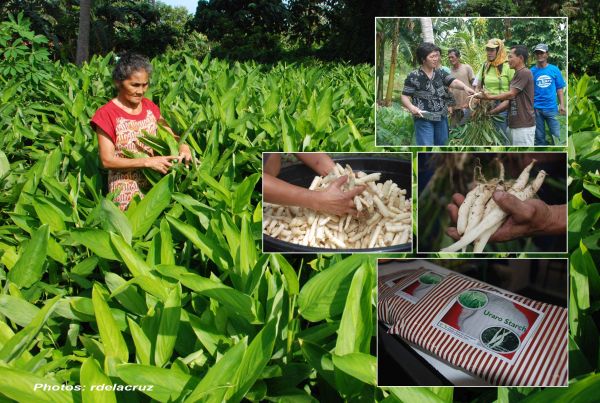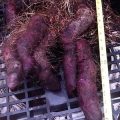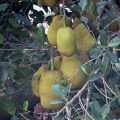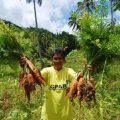Almost similar to cornstarch in being white, fine and powdery, the arrowroot powder is a healthier alternative. It is the only starch product with calcium ash which is important for the maintenance of proper acid and alkali balances in the human body (Fallon, 2000).
But before it becomes the white, nutritious powder that we know—an important ingredient in making arrowroot cookies and other baked products— it has to go through several processes first. One important of which is ensuring that there is an ample and continuous production of arrowroot (Maranta arundinacea) at the farm level.

From tubers to powder
In the early times, the Arawak tribe (natives of West Indies) widely used arrowroot for its medicinal properties specifically as antidote for poisoning. They placed the arrowroot on wounds to draw out the toxins due to poisoned arrows. It is from here that the term “arrowroot” is believed to have been taken from.
Arrowroot, locally known as “uraro” is a low perennial herbaceous plant with large spreading ovate leaves, thick and fleshy stem, and creeping rootstock that contains fleshy, scaly tubers. Although this crop is indigenous to tropical America, it is widely cultivated in tropical countries including the Philippines. It was introduced in the contry in 1918 but was not cultivated in a large scale. It was observed that the plant thrives best in areas where rainfall is uniformly distributed throughout the year.
The rhizome from the arrowroot plant is the main source of the starch that is extracted and sold in the market as a dry white powder. The powder from uraro is source of one of the purest form of carbohydrates which is highly digestible making it a suitable ingredient in making infant foods and medicinal tablets. Pure, quality starch is used in the making uraro biscuits, pastries, cookies, and other culinary goodies.
Improving uraro production through CPAR
Growing of arrowroot and processing them into uraro and uraro-based products has become a viable enterprise in Catanauan, Quezon making it as the One Town, One Product (OTOP). Currently, Catanauan is the source of arrowroot flour in Region 4A.
Adding to its demand, arrowroot flour is seen as possible substitute for wheat flour which could possibly lessen the country’s importation. The uraro flour is also seen as an effective subtitute of the corn requirement in broiler ration.
Given the potential of uraro and the many products (food and industrial uses) that could be derived from it, the demand for the quality, dry powder from arrowroot is increasing.
In a study conducted by the Department of Agriculture-Regional Field Unit (DA-RFU) 4A, Southern Tagalog Integrated Agricultural Research Center (STIARC), it was found that although there is a high demand for the arrowroot flour, the industry is beset by two major problems: low production due to occurrence of diseases and lack of processing equipment resulting to scarcity and poor quality of flour supply.
To address the problem, a Community-based Participatory Action Research (CPAR) on “Improved Arrowroot Production Technologies and Enhancement of the Arrowroot Starch and Flour in Catanauan, Quezon” was implemented. Leading the project was Rosemarie Bautista-Olfato, senior agriculturist and assistant manager of DA-RFU IVA, STIARC.
The project was implemented in 2009-2011 with 10 farmer-cooperators each in two CPAR sites: Matandang Sabang Silangan (MSS) and Matandang Sabang Kanluran (MSK).
The two-year CPAR project aimed to improve production of arrowroot tubers and marketability of the arrowroot starch and flour. Specifically, it aimed to: 1) increase production of arrowroot tubers from 4 tons to 8 tons per hectare through improved cultural practices and proper fertilization using organic farming technology; 2) improve the quality of arrowroot flour from small crumbs form into fine granules; 3) generate at least one processed product from arrowroot rhizomes/tubers; and 4) strengthen or reactivate one farmers’ organization in the two CPAR sites.
From the two CPAR site, five hectares of arrowroot were planted and were introduced technologies and interventions for improved production.
“We introduced a package of technology (POT) on improved production to our farmer cooperators. The POT included: preparing land thoroughly, using of new suckers every season, applying of organic fertilizer, planting in triangular manner, applying the 50×30 cm planting distance, and weeding 2-3 times,” explained Olfato.
In her report, results showed that application of the POT improved the production of tubers from 4 to 8.37 tons/ha in MSK and 15.20 tons/ha in MSS. “Generation of generation of starch and flour in both areas also increased,” added Olfato.
The problem on the lack of equipment necessary to process the rhizomes into flour, Olfato reported that, “tuber processing was improved through the machines developed by the Bicol University.”
She also mentioned that since the POT followed the basic principle of organic farming (applying only organic fertilizer), the generated products from arrowroot, including tubers, starch, and flour are all organics.
Through the project, farmer organizations in the two CPAR sites were reactivated, registered, and accredited. “We have also been conducting promotional activities in the sites so that more farmers will follow the same path. For our part, we have put in place mechanism including repayment schemes to sustain the project,” reported Olfato.
CPAR beneficiaries
After the two-year implementation of the CPAR project, has “there was increased in income; there was increased in production areas of arrowroot; and most of all, there was increased in farmer adoptors not only in the project site but outside of Catanauan, Quezon,” revealed Olfato.
It was shown that after two years in the two sites, return of investment (ROI) of 14.27% and 55.36% for MSK and MSS, respectively was reported. Moreover, with the increased number of adopters, the planting areas for arrowroot also increased, from 5 to 28 hectares.
The discrepancy was explained by Olfato as such: “The production cost in MSK was relatively low due to the price of planting materials where they were sourced. Meanwhile, the ROI in MSK resulted to 14.27 percent because tuber production was affected by the bacterial infection.”
In the second cropping, no more expenditure is to be spent for the purchasing of planting materials, hence, the amount is added to the income generated, thereby increasing profit. Partial mechanization of the processing of starch/flour could significantly cut expenditures on processing. With the use of processing machines, flour can be marketed as another product while the meal/bagasse can be made into paper as part of the value adding mechanism.
Improving lives through CPAR
One important indicator that a project was able to meet its objectives is if the farmers themselves have indeed improved their ways of living, economically.
“Improvements in some social indicators were shown after two-year implementation of the CPAR project,” cited Olfato.
As part of the profit generated from the sales of the arrowroot starch, many of the farmer-cooperators were able to finance the education of their children and pay hospital bills and other debt obligations.
“All of the farmer-cooperators in MSS are now able to provide themselves with drying implements used in the drying of starch. Previously, there is only one set of these implements that they share among themselves during the harvest season. Also, one farmer-cooperator was able to buy cements and hollow blocks to improve his present house at a cost of PhP 30,000” reported Olfato.
A farmer-cooperator in MSS was able to acquire 8 cows, 1 carabao and 14 head of piglets from the sales of arrowroot starch during the duration of the project.
One farmer-cooperator from MSS was able to have an electric power connection worth PhP 8,000 while the others were able to acquire television sets, DVD player, and a stereo speaker from their profits. ###
———-
This article was based from the study titled, “Community-based Participatory Action Research on Improved Arrowroot Production Technologies and Enhancement of the Arrowroot Starch and Flour in Catanauan, Quezon” by Rosemarie Bautista-Olfato, senior agriculturist/assistant manager, Department of Agriculture (DA), Regional Field Unit (RFU) 4A, Southern Tagalog Integrated Agricultural Research Center (STIARC), Marawoy, Lipa City.
References:
1. Fallon, Sally. October 2000. Nourishing Traditions. New Trends Publishing.
2. Arrowroot Powder and Its Many Uses. http://www.holistichealtharticles.com/Art/8849/399/Arrowroot-Powder-and-Its-Many-Uses.html
By: Rita T. dela Cruz, BAR Digest January-March 2012 Issue (Vol. 14 No.1)






Thats a good project , now where can i please get a little planting materials?